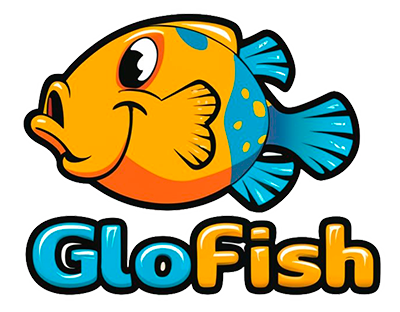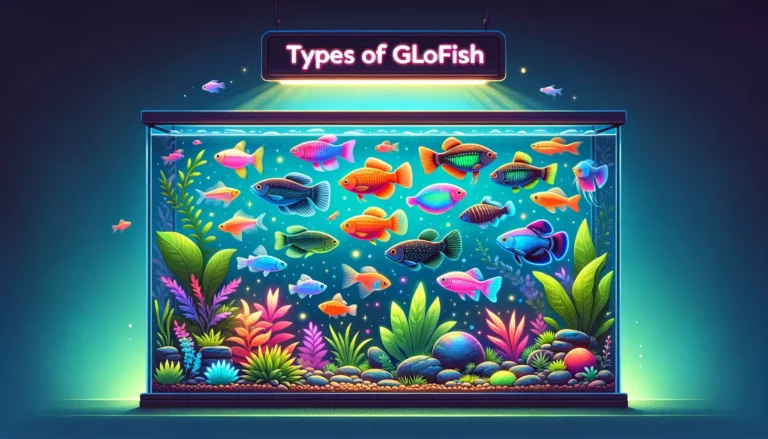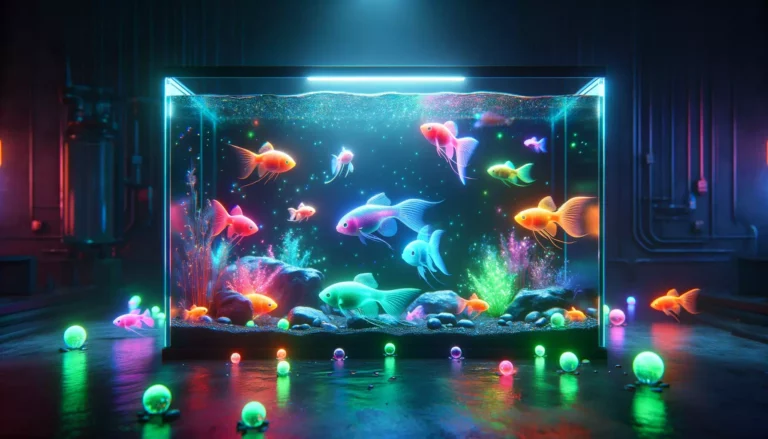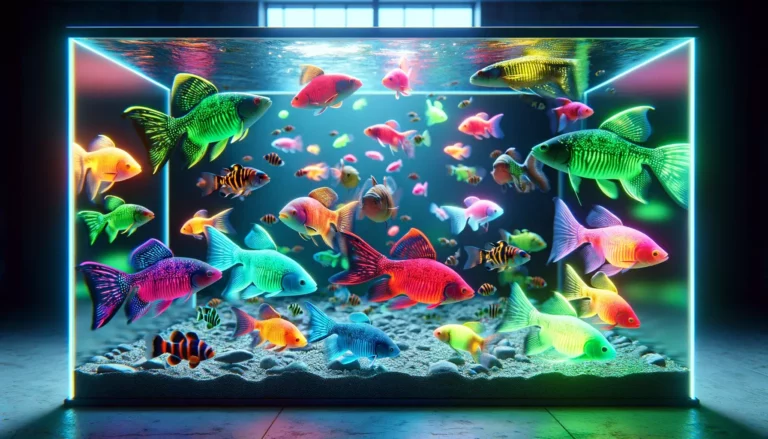Breeding GloFish at Home While Preserving Their Glowing Colors
Breeding GloFish at home can be a fascinating and rewarding endeavor for aquarium enthusiasts. These genetically modified fish are known for their vibrant, glowing colors, making them a captivating addition to any aquarium. In this post, we’ll delve into the art of breeding GloFish while maintaining the brilliance of their unique hues. From genetic modifications to ideal breeding conditions, we’ll explore the key factors that ensure the successful propagation of these remarkable aquatic creatures while keeping their luminescent charm intact.
Genetic Modifications in GloFish: Impacts on Breeding and Color Inheritance
GloFish, known for their vivid colors, are not found in nature. They are the result of genetic modifications. These modifications involve adding genes from fluorescent marine organisms. This process creates the bright, glowing appearance we see.
Understanding these modifications helps in breeding. The added genes are inheritable. That means the glowing trait can pass to the offspring. But the inheritance rate can vary. It’s not a 100% guarantee that all fry will glow as brightly as their parents.
GloFish breeding at home mirrors that of their non-modified counterparts. Yet, the genetic modifications can introduce unique challenges. Some GloFish may be less fertile than their natural counterparts. Breeders should be aware of this potential issue.
The vibrant colors are the main selling point of these fish. When breeding GloFish, maintaining the intensity of these colors in the fry is crucial. Environmental factors and genetics play a role in this. Breeders should aim for a stable, stress-free environment. This helps in maintaining the color vibrancy.
Optimal Water Conditions and Tank Setup for Breeding GloFish with Vibrant Colors
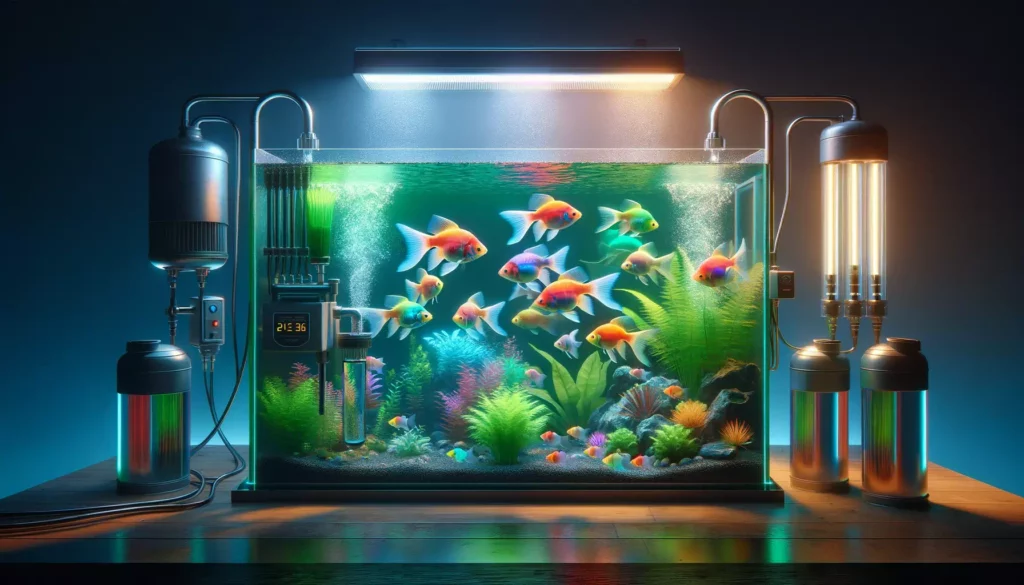
For GloFish to thrive and breed, the tank environment is key. Water quality, temperature, and tank setup directly influence breeding success. Ideal conditions mimic their natural habitat.
The water temperature should range between 72 and 82°F. Consistent temperatures are crucial. Fluctuations can stress the fish, impacting breeding and color vibrancy.
Water pH levels should be stable, ideally between 6.5 and 7.5. Regular monitoring is necessary. Sudden changes in pH can harm the fish and their fry.
The tank should have ample space for swimming. Overcrowding can lead to stress, affecting health and color. Plants and hiding spots are important too. They provide a natural, comforting environment. This is especially important for the fry, who need hiding places for safety.
Lighting plays a role in displaying the fish’s colors. But it should not be too intense or direct. GloFish are known for their glowing appearance under certain lights. Yet, their comfort should be the priority. Subdued, indirect lighting is best for their overall well-being.
By maintaining these conditions, breeders can provide a conducive environment. This not only supports the health and vibrancy of GloFish but also promotes successful breeding.
Comparing Breeding Behaviors: GloFish versus Non-Modified Fish and Special Home Breeding Considerations
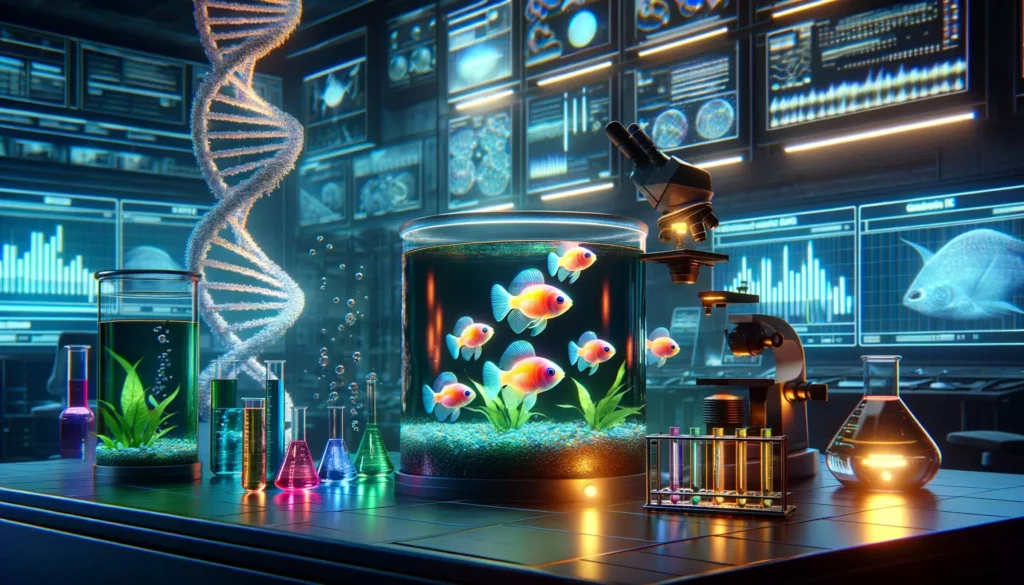
GloFish and their non-modified counterparts share many breeding behaviors. However, GloFish may exhibit unique needs due to their genetic modifications. Both types engage in similar mating rituals, like displaying vibrant colors or performing specific swimming patterns.
GloFish might be more sensitive to environmental changes. This sensitivity can affect their breeding behaviors. Stress from suboptimal conditions can lead to reduced breeding activity. It’s crucial to monitor the tank’s conditions closely. This includes maintaining clean water, proper temperature, and a stress-free environment.
Space is essential for breeding. GloFish, like their counterparts, need adequate space to perform mating rituals. A crowded tank can lead to stress and aggression. This can negatively impact breeding success.
Home breeders should note that GloFish may have different gestation periods or fry development rates compared to non-modified fish. Monitoring these differences is crucial for successful breeding. It ensures that the fry receive the care they need at the right time.
Special attention to diet is also important. A nutrient-rich diet supports health and vibrant colors. This is beneficial for both breeding behaviors and the overall well-being of the fish.
Inheritance of the Glowing Trait in GloFish Offspring: Factors Influencing Color Consistency and Intensity
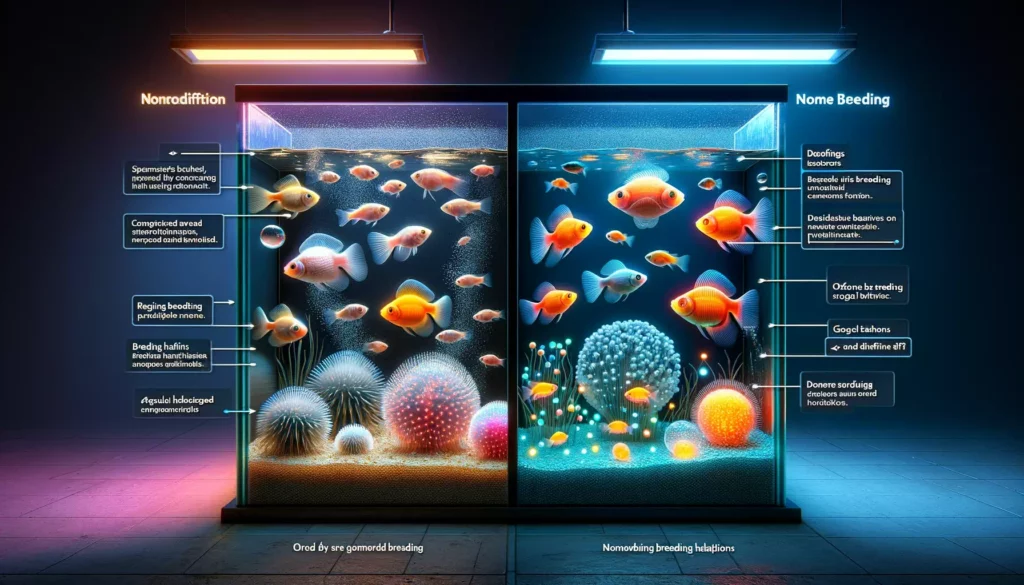
The glowing trait in GloFish is inheritable. However, not all offspring will display the same color intensity as their parents. Several factors influence this trait’s inheritance.
Genetics is the primary factor. The glowing trait’s expression can vary even among siblings. This variation results from the genetic combination each fry inherits. Not all will inherit the genes responsible for the brightest glow.
Environmental factors also play a role. Stress, poor diet, and suboptimal tank conditions can affect color expression. For the brightest colors, maintain a stable, stress-free environment and provide a rich, varied diet.
Age can influence color intensity. Young GloFish may not glow as brightly as mature ones. Their colors can intensify as they age. Breeders should consider this when assessing the color vibrancy of their GloFish fry.
Selective breeding can help in enhancing the glowing trait. By choosing parents with the most vibrant colors, breeders can increase the chances of brighter offspring. Yet, it’s important to maintain genetic diversity to ensure the health of the population.
Health Considerations in Breeding GloFish: Addressing Susceptibilities and Ensuring Fry Vitality
Breeding GloFish requires careful attention to their health. These fish might be more susceptible to certain conditions due to their genetic modifications. Monitoring their health is crucial for successful breeding and fry vitality.
| Aspect | Importance |
|---|---|
| Water Quality | – Paramount for fish health |
| – Regularly monitor pH, temperature, cleanliness | |
| – Maintaining stable conditions reduces stress | |
| Signs of Illness | – Early detection and treatment are crucial |
| – Look for behavior, appearance, and appetite changes | |
| Safe, Enriched Environment | – Encourages natural behaviors |
| – Vital for breeding success and overall well-being | |
| Isolation and Treatment | – Isolate and treat sick fish promptly |
| – Prevents disease spread | |
| – Use a separate quarantine tank |
Water quality is paramount. Poor water conditions can lead to stress and disease. Regularly check and maintain water parameters, including pH, temperature, and cleanliness. A stable environment reduces stress, promoting better health and breeding conditions.
Watch for signs of illness. These include changes in behavior, appearance, or appetite. Early detection and treatment of diseases are key to preventing spread and ensuring the well-being of the entire tank.
Provide a safe, enriched environment. Hiding places and a stress-free atmosphere encourage natural behaviors. This is important for breeding and for the well-being of the fish.
Isolate and treat sick fish immediately. This prevents disease spread and addresses health issues promptly. A separate quarantine tank is ideal for treating ill fish without affecting the others.
Nutritional Best Practices for Promoting Healthy Growth and Color Expression in GloFish Fry
Proper nutrition is crucial for GloFish fry to grow healthily and display vibrant colors. A balanced, varied diet promotes optimal growth and color expression.
Start with high-quality fry food. It should be rich in essential nutrients and small enough for the fry to eat. As they grow, gradually introduce a variety of foods. This ensures a balanced intake of proteins, fats, and vitamins.
Live or frozen foods can be beneficial. They provide protein and encourage natural hunting behaviors. Yet, ensure these foods are safe and free from contaminants.
Supplement with color-enhancing foods. These can help in maintaining and enhancing the vibrant colors of GloFish. Foods rich in carotenoids, for instance, can enhance red and orange colors.
Feed small amounts multiple times a day. Overfeeding can lead to poor water quality and health issues. Small, frequent meals are easier to digest and reduce waste.
Monitor the growth and health of the fry. Adjust the diet as needed to ensure they receive all the necessary nutrients. A well-fed GloFish fry is more likely to grow into a healthy, vibrant adult.
Managing Genetic Variations and Mutations in Home-Bred GloFish
Home breeding of GloFish can sometimes lead to genetic variations and mutations. Being aware and managing these variations is key to maintaining a healthy and vibrant GloFish population.
Understand the basics of GloFish genetics. Knowing how the glowing trait is inherited can help you anticipate and manage variations. Not all offspring will display the same color intensity due to genetic diversity.
| Aspect | Importance |
|---|---|
| Understand GloFish Genetics | – Knowledge of inheritance aids in managing variations |
| – Not all offspring may display the same color intensity | |
| Monitor Offspring Closely | – Observe fry for unexpected color or behavioral changes |
| Record Breeding Data | – Detailed records track genetic patterns and anomalies |
| Embrace Genetic Diversity | – Maintains population health, prevents inbreeding issues |
| Consult with Experts if Needed | – Seek guidance from vet or fish genetics expert for unusual cases |
Monitor the offspring closely. Keep an eye on the fry as they develop. Any unexpected changes in color or behavior may indicate a genetic mutation.
Record breeding data. Keep detailed records of breeding pairs and their offspring. This information can help track and understand genetic patterns or anomalies.
Embrace healthy genetic diversity. While maintaining the glowing trait is desirable, a certain level of genetic variation is healthy for the population. It can prevent issues related to inbreeding.
Consult with experts if needed. If you encounter unusual variations or mutations, seeking advice from a vet or a fish genetics expert can provide guidance on how to proceed.
Effective Pairing and Grouping Strategies for Breeding GloFish with Enhanced Color Vibrancy
Pairing and grouping GloFish strategically can enhance the chances of breeding offspring with vibrant colors. Choosing the right fish for breeding is crucial for maintaining the desired glowing traits.
| Strategy | Importance |
|---|---|
| Select Vibrantly Colored Parents | – Parental color intensity influences offspring colors |
| – Pairing brightly colored fish increases chances of vibrant fry | |
| Consider Breeding Fish Health | – Healthy parents are more likely to produce healthy offspring |
| – Monitor activity, appetite, and overall health of breeding fish | |
| Group by Color and Species | – Breeding within the same color and species yields predictability |
| Provide Optimal Breeding Environment | – Comfortable, stress-free conditions encourage successful breeding |
| – Tank conditions, hiding places, and diet all play a role | |
| Learn from Each Breeding Cycle | – Each experience provides insights for refining breeding strategy |
| – Note which pairings result in the most vibrant colors |
Select parents with strong, vibrant colors. The intensity of the parents’ colors often influences the offspring’s colors. Pairing two brightly colored fish can increase the chances of similarly vibrant fry.
Consider the health and vitality of the breeding fish. Healthy fish are more likely to produce healthy, vibrant offspring. Check for signs of good health such as activity levels, appetite, and clean, bright scales.
Group fish by color and species. GloFish come in different colors and species. Breeding within the same color and species can result in more predictable color outcomes.
Provide an optimal breeding environment. A comfortable, stress-free environment can encourage breeding. This includes the right tank conditions, hiding places, and a balanced diet.
Observe and learn from each breeding cycle. Each breeding experience can offer insights. Note which pairings result in the most vibrant colors and use this information to refine your breeding strategy.
Monitoring and Supporting the Early Development of GloFish Fry for Optimal Health and Color Retention
Caring for GloFish fry involves vigilant monitoring and support to ensure their health and color retention. Proper care during the early stages is crucial for the development of vibrant and healthy adult fish.
Create a safe nursery environment. The fry tank should be separate from the adult tank to protect the fry from being eaten or outcompeted for food. It should have clean, stable water conditions and be free from strong currents.
Feed the fry appropriately. Initially, GloFish fry may require infusoria or specially formulated fry food that is high in nutrients and small enough for them to eat. As they grow, gradually introduce them to a varied diet suitable for their size and species.
Monitor water quality rigorously. The fry are more sensitive to toxins and fluctuations in water conditions. Regular water changes and checks for proper pH, temperature, and ammonia levels are essential.
Watch for signs of healthy development and color emergence. Fry should be active, growing steadily, and starting to show color as they mature. Any deviations might require adjustments in care or diet.
Keep detailed records of growth and development. This helps in understanding the needs of the fry at different stages and can be useful for future breeding endeavors.
Future Prospects: Advances in Genetic Engineering and Breeding Techniques for Enhanced GloFish Vibrancy and Breeding Success
The field of genetic engineering and breeding is continuously evolving, offering exciting prospects for the future of GloFish. Innovations in these areas could lead to even more vibrant colors and successful breeding.
| Prospect | Significance |
|---|---|
| Advances in Genetic Engineering | – Potential for new color variations and intensified hues |
| – Discovery of novel fluorescent proteins and integration methods | |
| Improved Breeding Techniques | – Higher success rates in producing healthy, vibrant offspring |
| – Enhanced understanding of genetics and selective breeding | |
| – Creation of optimal breeding environments for GloFish | |
| Emerging Gene Editing Technologies | – More precise modifications for predictable color patterns |
| – Opportunities for improving health attributes of GloFish | |
| Ethical and Regulatory Considerations | – Shaping responsible and sustainable breeding practices |
| – Addressing concerns about the impact on ecosystems and the pet trade | |
| – Ensuring alignment with animal welfare and environmental standards |
Advances in genetic engineering might introduce new color variations or intensify existing ones. Researchers are continually discovering new fluorescent proteins and ways to integrate them into different species.
Improved breeding techniques could lead to higher success rates in producing healthy, vibrant offspring. This includes better understanding of genetics, selective breeding, and creating optimal environments for GloFish breeding.
Emerging technologies in gene editing, like CRISPR, could allow for more precise modifications. This might result in GloFish with more predictable color patterns and health attributes.
Ethical and regulatory considerations will continue to shape the future of GloFish breeding. As the technology advances, discussions around the impact of genetically modified organisms on ecosystems and the pet trade will be important.
Staying informed about these advances and the associated ethical considerations is crucial. It ensures that the breeding and keeping of GloFish remain responsible, sustainable, and aligned with the best practices in animal welfare and environmental stewardship.
